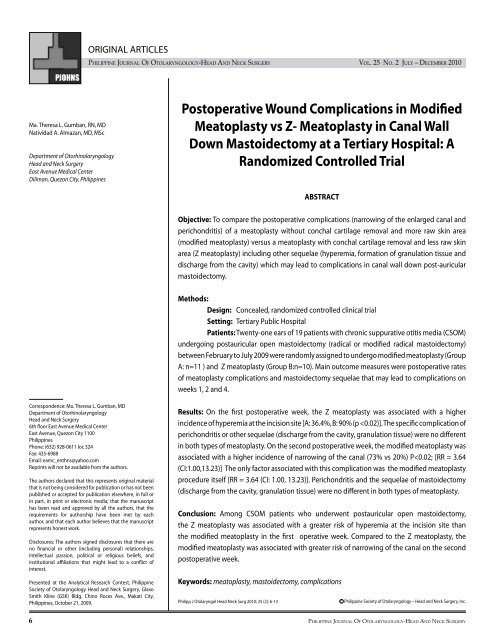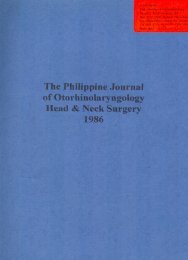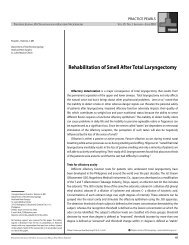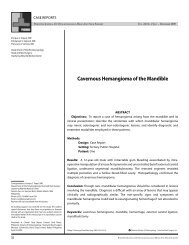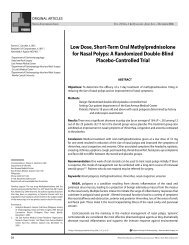Postoperative Wound Complications in Modified ... - PSO-HNS
Postoperative Wound Complications in Modified ... - PSO-HNS
Postoperative Wound Complications in Modified ... - PSO-HNS
You also want an ePaper? Increase the reach of your titles
YUMPU automatically turns print PDFs into web optimized ePapers that Google loves.
ORIGINAL ARTICLES<br />
Philipp<strong>in</strong>e Journal Of Otolaryngology-Head And Neck Surgery Vol. 25 No. 2 July – December 2010<br />
Ma. Theresa L. Gumban, RN, MD<br />
Natividad A. Almazan, MD, MSc<br />
Department of Otorh<strong>in</strong>olaryngology<br />
Head and Neck Surgery<br />
East Avenue Medical Center<br />
Diliman, Quezon City, Philipp<strong>in</strong>es<br />
<strong>Postoperative</strong> <strong>Wound</strong> <strong>Complications</strong> <strong>in</strong> <strong>Modified</strong><br />
Meatoplasty vs Z- Meatoplasty <strong>in</strong> Canal Wall<br />
Down Mastoidectomy at a Tertiary Hospital: A<br />
Randomized Controlled Trial<br />
ABSTRACT<br />
Objective: To compare the postoperative complications (narrow<strong>in</strong>g of the enlarged canal and<br />
perichondritis) of a meatoplasty without conchal cartilage removal and more raw sk<strong>in</strong> area<br />
(modified meatoplasty) versus a meatoplasty with conchal cartilage removal and less raw sk<strong>in</strong><br />
area (Z meatoplasty) <strong>in</strong>clud<strong>in</strong>g other sequelae (hyperemia, formation of granulation tissue and<br />
discharge from the cavity) which may lead to complications <strong>in</strong> canal wall down post-auricular<br />
mastoidectomy.<br />
Methods:<br />
Design: Concealed, randomized controlled cl<strong>in</strong>ical trial<br />
Sett<strong>in</strong>g: Tertiary Public Hospital<br />
Patients: Twenty-one ears of 19 patients with chronic suppurative otitis media (CSOM)<br />
undergo<strong>in</strong>g postauricular open mastoidectomy (radical or modified radical mastoidectomy)<br />
between February to July 2009 were randomly assigned to undergo modified meatoplasty (Group<br />
A: n=11 ) and Z meatoplasty (Group B:n=10). Ma<strong>in</strong> outcome measures were postoperative rates<br />
of meatoplasty complications and mastoidectomy sequelae that may lead to complications on<br />
weeks 1, 2 and 4.<br />
Correspondence: Ma. Theresa L. Gumban, MD<br />
Department of Otorh<strong>in</strong>olaryngology<br />
Head and Neck Surgery<br />
6th floor East Avenue Medical Center<br />
East Avenue, Quezon City 1100<br />
Philipp<strong>in</strong>es<br />
Phone: (632) 928-0611 loc 324<br />
Fax: 435-6988<br />
Email: eamc_enthns@yahoo.com<br />
Repr<strong>in</strong>ts will not be available from the authors.<br />
The authors declared that this represents orig<strong>in</strong>al material<br />
that is not be<strong>in</strong>g considered for publication or has not been<br />
published or accepted for publication elsewhere, <strong>in</strong> full or<br />
<strong>in</strong> part, <strong>in</strong> pr<strong>in</strong>t or electronic media; that the manuscript<br />
has been read and approved by all the authors, that the<br />
requirements for authorship have been met by each<br />
author, and that each author believes that the manuscript<br />
represents honest work.<br />
Disclosures: The authors signed disclosures that there are<br />
no f<strong>in</strong>ancial or other (<strong>in</strong>clud<strong>in</strong>g personal) relationships,<br />
<strong>in</strong>tellectual passion, political or religious beliefs, and<br />
<strong>in</strong>stitutional affiliations that might lead to a conflict of<br />
<strong>in</strong>terest.<br />
Presented at the Analytical Research Contest, Philipp<strong>in</strong>e<br />
Society of Otolaryngology Head and Neck Surgery, Glaxo<br />
Smith Kl<strong>in</strong>e (GSK) Bldg. Ch<strong>in</strong>o Roces Ave., Makati City,<br />
Philipp<strong>in</strong>es, October 21, 2009.<br />
Results: On the first postoperative week, the Z meatoplasty was associated with a higher<br />
<strong>in</strong>cidence of hyperemia at the <strong>in</strong>cision site [A: 36.4%, B: 90% (p
ORIGINAL ARTICLES<br />
Philipp<strong>in</strong>e Journal Of Otolaryngology-Head And Neck Surgery Vol. 25 No. 2 July – December 2010<br />
Meatoplasty refers to surgically alter<strong>in</strong>g the shape or size of the<br />
external open<strong>in</strong>g (meatus) of the external auditory canal. This portion<br />
of the ear canal is surrounded by cartilage. Therefore meatoplasty is an<br />
operation on the sk<strong>in</strong> and cartilage of the lateral one third of the external<br />
auditory canal. It is commonly done after perform<strong>in</strong>g mastoidectomy,<br />
regardless of approach. 1<br />
Before meatoplasty was developed by Stacke (1893) and Schwartze<br />
(1893) followed by Panse, Korner, Ballance and Siebermann, the<br />
<strong>in</strong>tentional creation of a postaural fistula after mastoidectomy was<br />
often done to facilitate management of the unsafe and diseased ear,<br />
such as <strong>in</strong> cases of s<strong>in</strong>us thrombosis and bra<strong>in</strong> abscess. 2<br />
Many papers have been published on different types of meatoplasty,<br />
show<strong>in</strong>g the advantage of each <strong>in</strong> creat<strong>in</strong>g a wide meatoplasty necessary<br />
for a mastoidectomy, entail<strong>in</strong>g removal of conchal cartilage, sutur<strong>in</strong>g it<br />
backwards, meatal pack<strong>in</strong>g or comb<strong>in</strong>ations thereof to facilitate a dry,<br />
clean, or easy to clean cavity. 3-9 However, there are very few papers that<br />
discuss the postoperative complications of meatoplasty.<br />
<strong>Complications</strong> of meatoplasty <strong>in</strong>clude <strong>in</strong>fection manifested by<br />
perichondritis, <strong>in</strong>fected granulation tissue and foul discharge. These<br />
may cause narrow<strong>in</strong>g of the external canal and eventual stenosis. In<br />
one study, Z meatoplasty had a 4% <strong>in</strong>cidence of perichondritis (1 <strong>in</strong> 24<br />
ears) and 12% <strong>in</strong>cidence of canal stenosis (3 <strong>in</strong> 24 ears). 10 A PubMED<br />
search us<strong>in</strong>g the terms “meatoplasty, complications” did not reveal any<br />
data regard<strong>in</strong>g complications of modified meatoplasty.<br />
This paper aimed to compare the postoperative complications<br />
between Z meatoplasty which entails removal of the conchal cartilage<br />
and heal<strong>in</strong>g by primary <strong>in</strong>tention and modified meatoplasty which<br />
preserves the conchal cartilage and heals by secondary <strong>in</strong>tention for<br />
patients with chronic suppurative otitis media undergo<strong>in</strong>g canal wall<br />
down mastoidectomy via a postauricular approach.<br />
MATERIALS AND METHODS<br />
N<strong>in</strong>eteen patients (9 males and 12 females aged 15-46 years)<br />
diagnosed with chronic suppurative otitis media who underwent postauricular<br />
canal down mastoidectomy from February 2009 to July 2009<br />
were <strong>in</strong>cluded <strong>in</strong> the study, which was conducted <strong>in</strong> accord with the<br />
Hels<strong>in</strong>ki Declaration of 1975. Fifteen patients were admitted at the Out<br />
Patient Department (OPD), three patients at the Emergency Room (ER)<br />
and one patient was referred from the Department of Surgery. Two of<br />
these patients underwent bilateral mastoidectomy mak<strong>in</strong>g a total of<br />
21 ears to <strong>in</strong>clude <strong>in</strong> the study. Patients with congenital or acquired<br />
external ear abnormalities were excluded.<br />
Randomization<br />
After approval from the department, separate <strong>in</strong>formed consents<br />
for mastoidectomy and <strong>in</strong>clusion <strong>in</strong> the study were obta<strong>in</strong>ed from the<br />
patients or their legal guardians. Patients were randomly assigned<br />
to undergo meatoplasty with the modified meatoplasty or the Z<br />
meatoplasty. Randomization was performed <strong>in</strong> blocks of two groups.<br />
Twenty one pieces of paper numbered 1 to 21 were placed <strong>in</strong> a bowl<br />
and surgeons were asked to draw one piece of paper each to determ<strong>in</strong>e<br />
the type of meatoplasty to be performed. The trial was concealed with<br />
one author hold<strong>in</strong>g the list of randomly assigned numbers to either<br />
modified meatoplasty or Z meatoplasty. This was accomplished us<strong>in</strong>g<br />
an <strong>in</strong>ternet-based Research Randomizer program (Social Psychology<br />
Network, Connecticut; USA). 11 The authors then <strong>in</strong>formed each surgeon<br />
what type of meatoplasty to use.<br />
Variables<br />
The surgeons <strong>in</strong>cluded <strong>in</strong> this study had the same level of<br />
competency <strong>in</strong> residency tra<strong>in</strong><strong>in</strong>g, but none had performed either<br />
modified meatoplasty or Z meatoplasty <strong>in</strong> previous mastoidectomies.<br />
Learn<strong>in</strong>g curves were not accounted for, as a pre-randomization tra<strong>in</strong><strong>in</strong>g<br />
was not conducted. Only one author assessed the variables studied.<br />
Procedure<br />
<strong>Modified</strong> Meatoplasty 12<br />
A modification of the Fisch meatoplasty 5 was employed with a 12<br />
o’clock endaural <strong>in</strong>cision without removal of conchal cartilage and<br />
allow<strong>in</strong>g heal<strong>in</strong>g by secondary <strong>in</strong>tention.<br />
The <strong>in</strong>cision is made <strong>in</strong> the fundus of the external auditory canal<br />
at 12 o’clock position, extend<strong>in</strong>g radially towards the root of the helix,<br />
turn<strong>in</strong>g 90 degrees to the direction of the concha, approximately 1.5<br />
to 2cm without overpass<strong>in</strong>g the helix (Figure 1). The <strong>in</strong>cision <strong>in</strong>cludes<br />
the full thickness of the external auditory canal and concha, creat<strong>in</strong>g a<br />
triangular flap with <strong>in</strong>ferior and lateral base (Figure 2). The flap, consist<strong>in</strong>g<br />
of sk<strong>in</strong>, soft tissue, cartilage and perichondrium is then rotated <strong>in</strong> a<br />
posterior and <strong>in</strong>ferior direction, then sutured to the digastric muscle<br />
us<strong>in</strong>g vicryl 3-0 (Ethicon, Johnson & Johnson: Somerville, New Jersey<br />
USA) (Figure 3). 1 In our study, the authors opted to suture the flap to<br />
the soft tissue on the deep surface of the p<strong>in</strong>na us<strong>in</strong>g chromic catgut<br />
3-0 (Ethicon, Johnson & Johnson: Somerville, New Jersey USA) due to<br />
f<strong>in</strong>ancial constra<strong>in</strong>ts.<br />
Z Meatoplasty<br />
First described by Fagan <strong>in</strong> 1998 4 and modified by Murray <strong>in</strong> 2000 13<br />
for use <strong>in</strong> endaural approach, Tunkel 10 <strong>in</strong> 2006 utilized the Z meatoplasty<br />
for a postauricular approach mastoidectomy on 24 ears <strong>in</strong> children with<br />
an 87.5% success rate. <strong>Complications</strong> noted <strong>in</strong> 12.5% (3 ears) were<br />
postoperative perichondritis and canal stenosis.<br />
Philipp<strong>in</strong>e Journal Of Otolaryngology-Head And Neck Surgery 7
ORIGINAL ARTICLES<br />
Philipp<strong>in</strong>e Journal Of Otolaryngology-Head And Neck Surgery Vol. 25 No. 2 July – December 2010<br />
The <strong>in</strong>cision is made along the posterior and <strong>in</strong>ferior conchal borders<br />
and along the posterior ear canal meatus (Figure 4). A flap of conchal<br />
sk<strong>in</strong> just above the perichondrium is elevated posterosuperiorly. A<br />
posterior canal flap is also made above the perichondrium, this creates<br />
an <strong>in</strong>feriorly based flap. The conchal and posterior external canal<br />
cartilage are excised along with underly<strong>in</strong>g soft tissue (Figure 5). The<br />
conchal sk<strong>in</strong> flap is then rotated medially and sutured to the deep<br />
surface of the p<strong>in</strong>na us<strong>in</strong>g chromic catgut 3-0. The posterior canal flap is<br />
rotated laterally and sutured to the edge of the <strong>in</strong>ferior conchal <strong>in</strong>cision<br />
us<strong>in</strong>g chromic 3-0 (Ethicon, Johnson & Johnson: Somerville, New Jersey<br />
USA) (Figure 6). 10<br />
Chlorhexad<strong>in</strong>e acetate 0.5% tulle gras dress<strong>in</strong>g BP (para-tulle®.<br />
Cotton Craft (pvt.), Ltd. Lahore, Pakistan) or 1% soframyc<strong>in</strong> (framycet<strong>in</strong><br />
sulfate) lano-paraff<strong>in</strong> (anhydrous lanol<strong>in</strong> 9.95%) gauze dress<strong>in</strong>g BP<br />
(sofra-tulle®. Sanofi-Aventis: Mumbai, India) gauze dress<strong>in</strong>g was utilized<br />
as a mastoid cavity pack based on availability.<br />
Figure 1. Endaural <strong>in</strong>cision extend<strong>in</strong>g to root of helix, turn<strong>in</strong>g 90 degrees to concha. Adapted from:<br />
Almario JE, Lora JG, Prieto JA, Correa A. <strong>Modified</strong> meatoplasty surgical technique for canal wall down<br />
mastoidectomy. Grupo Médico Otológico. 2005. [cited 2009 Sep]: [about 3 p.] Available from: http://<br />
www.susmedicos.com/ articulos_otologia_modified-meatoplasty.htm<br />
<strong>Postoperative</strong> Evaluation:<br />
Patients were followed up on the first and second week post surgery.<br />
The follow<strong>in</strong>g parameters were observed by a s<strong>in</strong>gle author: 1) presence<br />
of hyperemia, discharge from the external canal or granulation tissue<br />
and 2) narrow<strong>in</strong>g of the meatus and/or perichondritis.<br />
Statistical Analysis:<br />
Post hoc computation of the estimation of the study sample size<br />
was based on the proportion of the variable, narrow<strong>in</strong>g of the external<br />
auditory canal. The sample size was sufficient to make an analysis based<br />
on the computed 8 ears per group: Group A (<strong>Modified</strong> Meatoplasty)<br />
and Group B (Z meatoplasty). Randomly assign<strong>in</strong>g 21 patients to each<br />
group would allow detection of this difference <strong>in</strong> rate of narrow<strong>in</strong>g of<br />
the canal complication rate with 80% power and a 2-tailed significance<br />
level of 0.5. No <strong>in</strong>terim analysis was performed. All patients were<br />
analyzed <strong>in</strong> the group to which they were randomly assigned accord<strong>in</strong>g<br />
to the <strong>in</strong>tention-to-treat pr<strong>in</strong>ciple. (Appendix)<br />
Data was encoded and tallied <strong>in</strong> SPSS version 10 for w<strong>in</strong>dows<br />
(IBM; Chicago, Ill<strong>in</strong>ois, USA). Descriptive statistics were generated for<br />
all variables. For nom<strong>in</strong>al data, frequencies and percentages were<br />
computed while mean ± SD were generated for numerical data.<br />
Comparison of the different variables was performed us<strong>in</strong>g the T<br />
test, Fisher Exact test and Chi-square test. Relative Risk (RR) based on<br />
confidence <strong>in</strong>tervals was also computed for the variable- narrow<strong>in</strong>g of<br />
the external ear canal.<br />
Each sequela or complication was analyzed <strong>in</strong> the first, second and<br />
fourth week postoperatively. All P values were based on two-tailed<br />
Figure 2. Triangular flap with <strong>in</strong>ferior and lateral base. Adapted from: Almario JE, Lora JG, Prieto JA,<br />
Correa A. <strong>Modified</strong> meatoplasty surgical technique for canal wall down mastoidectomy. Grupo Médico<br />
Otológico. 2005. [cited 2009 Sep]: [about 3 p.] Available from: http://www.susmedicos.com/ articulos_<br />
otologia_modified-meatoplasty.htm<br />
Figure 3. Triangular flap, consist<strong>in</strong>g of sk<strong>in</strong>, soft tissue, cartilage and perichondrium rotated <strong>in</strong> a<br />
posterior and <strong>in</strong>ferior direction, sutured to the digastric muscle.<br />
8 Philipp<strong>in</strong>e Journal Of Otolaryngology-Head And Neck Surgery
ORIGINAL ARTICLES<br />
Philipp<strong>in</strong>e Journal Of Otolaryngology-Head And Neck Surgery Vol. 25 No. 2 July – December 2010<br />
Figure 4. Incision along posterior and <strong>in</strong>ferior conchal borders and posterior canal meatus. Adapted<br />
from: Tunkel DE. The Z-meatoplasty for modified radical mastoidectomy <strong>in</strong> children. Arch Otolaryngol<br />
Head Neck Surg. 2006 Dec; 132(1):1319-1322<br />
Figure 5. A Conchal sk<strong>in</strong> flap elevated superiorly and <strong>in</strong>feriorly-based posterior canal flap. Adapted<br />
from: Tunkel DE. The Z-meatoplasty for modified radical mastoidectomy <strong>in</strong> children. Arch Otolaryngol<br />
Head Neck Surg. 2006 Dec; 132(1):1319-1322<br />
meatoplasty (Table 1). These <strong>in</strong>clude sex, age and type of mastoidectomy.<br />
In Group A, five (45.5%), were male and six (54.5%) were female and <strong>in</strong><br />
Group B, four (40%) were male and six (60%) were female (p=0.84). The<br />
mean ages for Group A and B were 30 and 31 years old, respectively<br />
(p=1.0). There were two types of open mastoidectomy for both groups,<br />
the Radical Mastoidectomy and <strong>Modified</strong> Radical Mastoidectomy.<br />
Radical mastoidectomy was performed on eight ears (72.7%) <strong>in</strong> Group<br />
A and four ears (40%) <strong>in</strong> Group B, while modified radical mastoidectomy<br />
was performed on three ears (27.3%) <strong>in</strong> Group A and six ears (60%) <strong>in</strong><br />
Group B (P=0.19).<br />
For co-morbidities of the disease (Table 2), cholesteatoma was<br />
present <strong>in</strong> six (54.5%) and five (50%) <strong>in</strong> Groups A and B, respectively;<br />
subperiosteal abscess was present <strong>in</strong> one (9.1% and 10%) <strong>in</strong> Groups A<br />
and B, respectively; temporal lobe abscess was present <strong>in</strong> two (18.2%)<br />
and one (10%) <strong>in</strong> Group A and B, respectively; and men<strong>in</strong>gitis and facial<br />
paralysis were each present <strong>in</strong> one (9.1%) <strong>in</strong> Group A with neither comorbidity<br />
present <strong>in</strong> Group B.<br />
With regard mastoidectomy sequelae, mastoid cavity discharge<br />
(Table 3) was not significantly different <strong>in</strong> Groups A and B at all <strong>in</strong>tervals<br />
of observation (first, second and fourth week). Hyperemia (Table 4) was<br />
significantly higher <strong>in</strong> Group B (Z meatoplasty) dur<strong>in</strong>g the first week<br />
than <strong>in</strong> Group A (modified meatoplasty) [A: 36.4%, B: 90% (p
ORIGINAL ARTICLES<br />
Philipp<strong>in</strong>e Journal Of Otolaryngology-Head And Neck Surgery Vol. 25 No. 2 July – December 2010<br />
had radical mastoidectomy failed due to an <strong>in</strong>adequate meatus.<br />
In our study, third year residents complet<strong>in</strong>g their requirements<br />
for mastoidectomy procedures <strong>in</strong>clud<strong>in</strong>g the author who did the<br />
assessment were the ma<strong>in</strong> surgeons. Although the surgeons each<br />
had nearly completed half the number of required mastoidectomies<br />
<strong>in</strong> their residency tra<strong>in</strong><strong>in</strong>g program at the time of this study, none of<br />
them had previously performed either a modified or Z meatoplasty nor<br />
had pre-randomization tra<strong>in</strong><strong>in</strong>g been conducted. These should also be<br />
considered <strong>in</strong> assess<strong>in</strong>g results of our study.<br />
While ear discharge that eventually dries up is an expected sequel<br />
of mastoidectomy, persistent and foul discharge after mastoidectomy<br />
may result from an <strong>in</strong>adequately drilled mastoid bowl, a high facial ridge<br />
and residual <strong>in</strong>fection. Although this was not assessed <strong>in</strong> our study, a<br />
common factor was the surgical procedure of radical mastoidectomy<br />
(which may also have been reflective of worse ears to beg<strong>in</strong> with<br />
compared to those that needed modified radical mastoidectomy only).<br />
Although the difference between the two groups was not significant,<br />
there was a trend of decreas<strong>in</strong>g p value from the first week to the fourth<br />
week (p=first week, 1.00; second week, 0.66 and fourth week, 0.15).<br />
Perhaps with a longer period of observation, the discharge would no<br />
longer be present as the cavity re-epithelialized. None of the discharge<br />
noted orig<strong>in</strong>ated from the meatoplasty <strong>in</strong>cision site.<br />
An <strong>in</strong>flammatory response starts with <strong>in</strong>creased blood flow<br />
due to vasodilation, caus<strong>in</strong>g hyperemia; and <strong>in</strong>creased vascular<br />
permeability leads to edema and a cascade of immune responses. 19<br />
Reactive hyperemia is the transient <strong>in</strong>crease <strong>in</strong> blood flow follow<strong>in</strong>g<br />
a brief period of ischemia. Influx of vasoactive substances <strong>in</strong> response<br />
to prolonged stress further contributes to this. The redness at the<br />
edges of the meatoplasty <strong>in</strong>cision may represent the <strong>in</strong>itial phase of<br />
revascularization, possibly exacerbated by more sk<strong>in</strong> manipulation as<br />
seen on Group B. In the first week, the <strong>in</strong>cidence of hyperemia was<br />
found to be higher <strong>in</strong> Group B (Z meatoplasty) p
ORIGINAL ARTICLES<br />
Philipp<strong>in</strong>e Journal Of Otolaryngology-Head And Neck Surgery Vol. 25 No. 2 July – December 2010<br />
Table 4. Distribution of Subjects Accord<strong>in</strong>g to Hyperemia at Different Intervals<br />
Between the <strong>Modified</strong> Meatoplasty and the Z meatoplasty<br />
Interval Group A:<br />
<strong>Modified</strong> Meatoplasty<br />
(n= 11)<br />
1 week<br />
(+)<br />
(-)<br />
2 weeks<br />
(+)<br />
(-)<br />
4 weeks†<br />
(+)<br />
(-)<br />
4 (36.4%)<br />
7 (63.6%)<br />
5 (45.5%)<br />
6 (54.5%)<br />
2<br />
7<br />
Group B:<br />
Z meatoplasty<br />
(n=10)<br />
9 (90.0%)<br />
1 (10.0%)<br />
4 (40.0%)<br />
6 (60.0%)<br />
† p value at 4 weeks with <strong>in</strong>tention to treat mak<strong>in</strong>g the lost to ff-up neg= 1.00<br />
p value at 4 weeks with <strong>in</strong>tention to treat mak<strong>in</strong>g the lost to ff-up pos= 1.00<br />
p value at 4 weeks with <strong>in</strong>tention to treat mak<strong>in</strong>g the lost to ff-up pos/neg= 1.00<br />
1<br />
7<br />
P value<br />
0.02 (S)<br />
1.00 (NS)<br />
1.00 (NS)<br />
Table 5. Distribution of Subjects Accord<strong>in</strong>g to Granulation at Different Intervals<br />
Between the <strong>Modified</strong> Meatoplasty and the Z meatoplasty<br />
Interval Group A:<br />
<strong>Modified</strong> Meatoplasty<br />
(n= 11)<br />
1 week<br />
(+)<br />
(-)<br />
2 weeks<br />
(+)<br />
(-)<br />
4 weeks§<br />
(+)<br />
(-)<br />
7 (63.6%)<br />
4 (36.4%)<br />
10 (90.9%)<br />
1 ( 9.1%)<br />
4<br />
5<br />
Group B:<br />
Z meatoplasty<br />
(n=10)<br />
6 (60.0%)<br />
4 (40.0%)<br />
7 (70.0%)<br />
3 (30.0%)<br />
§ p value at 4 weeks with <strong>in</strong>tention to treat mak<strong>in</strong>g the lost to ff-up neg= 0.64<br />
p value at 4 weeks with <strong>in</strong>tention to treat mak<strong>in</strong>g the lost to ff-up pos= 0.67<br />
p value at 4 weeks with <strong>in</strong>tention to treat mak<strong>in</strong>g the lost to ff-up pos/neg= 0.65<br />
2<br />
6<br />
P value<br />
1.00 (NS)<br />
0.31 (NS)<br />
0.61 (NS)<br />
Table 6. Distribution of Subjects Accord<strong>in</strong>g to Perichondritis at Different<br />
Intervals Between the <strong>Modified</strong> Meatoplasty and the Z meatoplasty<br />
Interval Group A:<br />
<strong>Modified</strong> Meatoplasty<br />
(n= 11)<br />
1 week<br />
(+)<br />
(-)<br />
2 weeks<br />
(+)<br />
(-)<br />
4 weeks‡<br />
(+)<br />
(-)<br />
2 (18.2%)<br />
9 (81.8%)<br />
4 (36.4%)<br />
7 (63.6%)<br />
2<br />
9<br />
Group B:<br />
Z meatoplasty<br />
(n=10)<br />
0<br />
10 (100%)<br />
0<br />
10 (100%)<br />
0<br />
10<br />
‡ p value at 4 weeks with <strong>in</strong>tention to treat mak<strong>in</strong>g the lost to ff-up neg= 0.48<br />
p value at 4 weeks with <strong>in</strong>tention to treat mak<strong>in</strong>g the lost to ff-up pos= 0.64<br />
p value at 4 weeks with <strong>in</strong>tention to treat mak<strong>in</strong>g the lost to ff-up pos/neg= 0.58<br />
P value<br />
0.48 (NS)<br />
0.09 (NS)<br />
1.00 (NS)<br />
The conchal cartilage is an extremely elastic structure with uniform<br />
thickness <strong>in</strong> its upper two-thirds that gradually <strong>in</strong>creases <strong>in</strong> thickness<br />
towards its <strong>in</strong>ferior aspect. 22 It is malleable but is not permanently<br />
distorted from its orig<strong>in</strong>al shape with <strong>in</strong>creas<strong>in</strong>g stress. However, the<br />
stra<strong>in</strong> of conchal cartilage is dependent on the abundance of elastic<br />
fibers and <strong>in</strong>creases the flexibility of the cartilage <strong>in</strong> response to<br />
stress. Simply, conchal cartilage is dependent on the elastic memory<br />
or cartilage recoil. Narrow<strong>in</strong>g of the meatoplasty was assessed by<br />
the capability to visualize the mastoid cavity. If the p<strong>in</strong>na had to be<br />
manipulated to view the cavity, the meatoplasty was considered<br />
<strong>in</strong>adequate. In Group A (modified meatoplasty), resection of the sk<strong>in</strong><br />
at the superior edge and pull<strong>in</strong>g of conchal cartilage <strong>in</strong>feriorly and<br />
posteriorly created a wide (albeit, <strong>in</strong>feroposteriorly-displaced) cavity.<br />
The subcutaneous tissue and cartilage adds bulk to the pulled-back<br />
concha and this may be the major factor for the 72.7% narrow<strong>in</strong>g of<br />
the canal seen dur<strong>in</strong>g the second week post operation. Posterior<br />
rotation of the auricle may have been prevented by plac<strong>in</strong>g several<br />
sutures deep <strong>in</strong>to the soft tissue more superiorly with retraction of the<br />
auricle anteriorly. 18 Sutur<strong>in</strong>g to the undersurface of the p<strong>in</strong>na <strong>in</strong>stead<br />
of utiliz<strong>in</strong>g the digastric muscle obviated the need for additional<br />
sutures. Insufficient extension of the <strong>in</strong>cision towards the helical root<br />
and further modification of the surgical technique by substitut<strong>in</strong>g a<br />
weaker, more affordable chromic suture may also have contributed to<br />
the narrow<strong>in</strong>g of the canal. In Group B (Z-meatoplasty), the conchal<br />
cartilage, perichondrium and soft tissues were removed and the sk<strong>in</strong><br />
sutured via z-plasty us<strong>in</strong>g chromic catgut with little sk<strong>in</strong> tension. The<br />
relative risk of narrow<strong>in</strong>g of the external auditory canal was 3.64 higher<br />
<strong>in</strong> Group A than <strong>in</strong> Group B on the second week of observation. This<br />
was the only variable with significant differences <strong>in</strong> the two groups on<br />
the second week (p
ORIGINAL ARTICLES<br />
Philipp<strong>in</strong>e Journal Of Otolaryngology-Head And Neck Surgery Vol. 25 No. 2 July – December 2010<br />
Group B (60%, 70%) had a high <strong>in</strong>cidence of the development of<br />
granulation tissue. Although Group A had larger raw areas for heal<strong>in</strong>g<br />
by secondary <strong>in</strong>tention, Group B also developed granulation tissue.<br />
While this may reflect the normal heal<strong>in</strong>g process, it may also result<br />
from basically unclean mastoidectomy cavities expos<strong>in</strong>g both groups<br />
to <strong>in</strong>fection. Whether the use of chlorhexid<strong>in</strong>e tulle gras or soframyc<strong>in</strong><br />
gauze dress<strong>in</strong>g had an effect on granulation tissue formation was not<br />
documented <strong>in</strong> this study either.<br />
The goal of surgery is to achieve primary <strong>in</strong>tention heal<strong>in</strong>g with<br />
m<strong>in</strong>imal edema, no serious discharge or <strong>in</strong>fection without separation<br />
of wound edges and with m<strong>in</strong>imal scar formation. In meatoplasty,<br />
surgical <strong>in</strong>cisions are allowed to heal by delayed primary <strong>in</strong>tention and<br />
the wound is <strong>in</strong>itially left open. <strong>Wound</strong> edges <strong>in</strong> this case are brought<br />
together at about 4-6 days before granulation tissue is visible. 25 This<br />
method is often used after traumatic <strong>in</strong>jury or “dirty” surgery. Because<br />
of the presence of <strong>in</strong>fection and excessive trauma or sk<strong>in</strong> loss <strong>in</strong><br />
mastoidectomy and meatoplasty, the wound edges come together<br />
naturally by means of granulation and contraction 26 as seen <strong>in</strong> our<br />
cases.<br />
The natural heal<strong>in</strong>g process dictates that granulation tissues beg<strong>in</strong><br />
to be visible by the first week and as the aural pack is to be removed<br />
after one week, the template for the canal outl<strong>in</strong>e is also removed. This<br />
may expla<strong>in</strong> the outgrowth of granulation tissue <strong>in</strong> the second week<br />
<strong>in</strong> both groups. Group A (modified meatoplasty) had larger raw areas<br />
that allowed heal<strong>in</strong>g by secondary <strong>in</strong>tention, promot<strong>in</strong>g the outgrowth<br />
of more granulation tissue. Additional trauma and contam<strong>in</strong>ants<br />
brought about by egress of discharge from the mastoid may expla<strong>in</strong><br />
the <strong>in</strong>creased number of ears with higher relative risks of develop<strong>in</strong>g<br />
narrow<strong>in</strong>g of the canal after modified meatoplasty <strong>in</strong> Group A, 3.64x<br />
higher than after Z meatoplasty <strong>in</strong> Group B.<br />
In the first week, the post operative complication of perichondritis<br />
and mastoidectomy sequelae of granulation tissue formation and<br />
mastoid cavity discharge showed no significant difference between the<br />
two groups.<br />
Among CSOM patients who underwent postauricular open<br />
mastoidectomy, the Z meatoplasty was associated with a greater risk<br />
of hyperemia at the <strong>in</strong>cision site than the modified meatoplasty <strong>in</strong> the<br />
first operative week [A: 36.4%, B: 90% (p
ORIGINAL ARTICLES<br />
Philipp<strong>in</strong>e Journal Of Otolaryngology-Head And Neck Surgery Vol. 25 No. 2 July – December 2010<br />
Appendix<br />
Post Hoc Computation of the sample size based on<br />
proportion of narrow<strong>in</strong>g alone<br />
ACKNOWLEDGMENT<br />
Special thanks to the first author’s co-residents who performed the surgeries: Sherlyn C.<br />
Ng Tsai, MD, Crist<strong>in</strong>a S. Nieves, MD and Carolynne F. Unay, MD, who also made the operative<br />
procedure illustrations.<br />
Where:<br />
n = is the number of subjects needed<br />
P1 = 72.7% = 0.727 (estimated proportion of<br />
complication <strong>in</strong> the modified meatoplasty)<br />
Q1 = 1 – P1 = 1 – 0.727 = 0.273<br />
P2 = 20% = 0.20 (estimated proportion of<br />
complication <strong>in</strong> the z meatoplasty)<br />
Q2 = 1 – P2 = 1 – 0.20 = 0.80<br />
p = (P1+P2)/2 = (0.727+0.20)/2 = 0.4635<br />
q = 1 – p = 1 – 0.4635 = 0.5365<br />
Zα = 95% confidence level = 1.96<br />
Zβ= 80% power of the study = 1.28<br />
n = 8/group<br />
REFERENCES<br />
1. Myers E, Carreria R, Eibl<strong>in</strong>g D, Ferris R, Gillman G, Golla S. Operative otolaryngology. 2 nd<br />
ed.Vol 2. Philadelphia: W B Saunders; 1997. p.1280.<br />
2. Sellars SL. The orig<strong>in</strong>s of mastoid surgery. S Afr Med J. 1974 Feb 9; 48(6): 234-242.<br />
3. Raut VV, Rutka JA. The Toronto meatoplasty: enhanc<strong>in</strong>g one’s results <strong>in</strong> canal wall<br />
down procedures. Laryngoscope. 2002 Nov; 112(11): 2093-5<br />
4. Fagan P, Ajal M. Z-meatoplasty of the external auditory canal. Laryngoscope. 1998 Sep;<br />
108:1421-1422<br />
5. Fisch U. Tympanoplasty, mastoidectomy and stapedectomy. New York, NY: Thieme;<br />
2008. p 39<br />
6. Portmann M. “How I do it”—otology and neurotology. A specific issue and its solution.<br />
Meatoplasty and conchoplasty <strong>in</strong> cases of open technique. Laryngoscope. 1983 Apr;<br />
93(4):520-522<br />
7. Susk<strong>in</strong>d DL, Bigelow CD, Knox GW. Y-modification of the Fisch meatoplasty.<br />
Otolaryngol Head Neck Surg. 1999 Jul; 121 (1):126-7.<br />
8. Potsic WP, Cotton RT, Handler SD. Surgical pediatric otolaryngology. New York. Thieme<br />
Medical Publishers; 1997. p 54<br />
9. Sanna M, Sunose H, Manc<strong>in</strong>i F. Middle ear and mastoid microsurgery. New York Thieme<br />
Medical Publishers: 2003. p 279<br />
10. Tunkel DE. The Z-meatoplasty for modified radical mastoidectomy <strong>in</strong> children. Arch<br />
Otolaryngol Head Neck Surg. 2006 Dec; 132(1):1319-1322.<br />
11. Research Randomizer. Connecticut: Social Psychology Network; c1997-2010 [updated<br />
2007; cited Aug 26,2009]. Available from: http://www.randomizer.org<br />
12. Almario JE, Lora JG, Prieto JA, Correa A. <strong>Modified</strong> meatoplasty surgical technique<br />
for canal wall down mastoidectomy. Grupo Médico Otológico. 2005. [cited 2009<br />
Sep]:Available from: http://www.susmedicos.com/articulos_otologia_modifiedmeatoplasty.htm<br />
13. Murray DP, Jassar P, Lee MSW, Veitch DY. Z-meatoplasty technique <strong>in</strong> endaural<br />
mastoidectomy. J Laryngol Otol. 2000; 114:526-527<br />
14. Cumm<strong>in</strong>gs CW, Fl<strong>in</strong>t PW, Harker LA, Haughey BH, Richardson MA, Robb<strong>in</strong>s KT, Schuller<br />
DE, Thomas, JR, editors. Cumm<strong>in</strong>gs otolaryngology head and neck surgery, 4 th ed. Vol<br />
4. Philadelphia (PA): Mosby, c2005. p3082.<br />
15. Phelan E, Harney M, Burns H. Intraoperative f<strong>in</strong>d<strong>in</strong>gs <strong>in</strong> revision canal wall down<br />
mastoidectomy. Ir Med J. 2008 Jan; 101(1):14.<br />
16. Berc<strong>in</strong> S, Kutluhan A, Bozdemir K, Yalc<strong>in</strong>er G, Sari N, Karamese O. Results of revision<br />
mastoidectomy. Acta Otolaryngol. 2009 Feb; 129(2): 138-141.<br />
17. Faramarzi A, Motasaddi-Zarandy M, Khorsandi MT. Intraoperative f<strong>in</strong>d<strong>in</strong>gs <strong>in</strong> revision<br />
chronic otitis media surgery. Arch Iran Med. 2008 Mar;11 (2): 196-199.<br />
18. Yang N, Chiong C. Results of radical mastoidectomy <strong>in</strong> the Philipp<strong>in</strong>e General Hospital.<br />
[monograph on the Internet]. Advanced Science and Technology Institute (ASTI);<br />
c2009 [cited 2009 Sep]. Available from: http://202.90.159.173/gsdl/collect/actamedi/<br />
<strong>in</strong>dex/assoc/HASHdcce.dir/doc.pdf<br />
19. Sell S, Max E. Immunology, immunopathology and immunity. 6 th edition, illustrated.<br />
New York. ASM press; 2001. p 564<br />
20. Medl<strong>in</strong>e plus onl<strong>in</strong>e encyclopedia. Perichondritis. 2008 Sep 8. [cited sep 2009].<br />
Available from: http://www.nlm.nih.gov/medl<strong>in</strong>eplus/ency/article/001253.htm.<br />
21. Glasscock M, Gulya A. Glasscock-Shambaugh surgery of the ear. Chicago. PMPH USA;<br />
2003. p 346-347.<br />
22. Man-Kai Tang H. The conchal cartilage effect of its management on the size of the<br />
meatoplasty and the outcome of the open mastoidectiomy. Thesis. Published by<br />
University of Hong Kong. 2001 [cited Sep 2009]. Available from: http://hub.hku.hk/<br />
handle/123456789/26623<br />
23. Sussman C, Bates-Jensen B. <strong>Wound</strong> care: a collaborative practice manual for health<br />
professionals.3 rd edition. Philadelphia – Baltimore. Wolters Kluwer – Lipp<strong>in</strong>cott<br />
Williams & Wilk<strong>in</strong>s. 2007; p.21.<br />
24. Gottrup F. <strong>Wound</strong> closure techniques. J <strong>Wound</strong> Care. 1999; 8(8): 397-400.<br />
25. Thomas S. <strong>Wound</strong> management and dress<strong>in</strong>gs. London, UK: Pharmaceutical<br />
Press;1990: p. 69-73<br />
26. Haberman R. Middle ear and mastoid surgery. New York. Thieme Medical Publishers;<br />
2004. p. 189<br />
Philipp<strong>in</strong>e Journal Of Otolaryngology-Head And Neck Surgery 13


